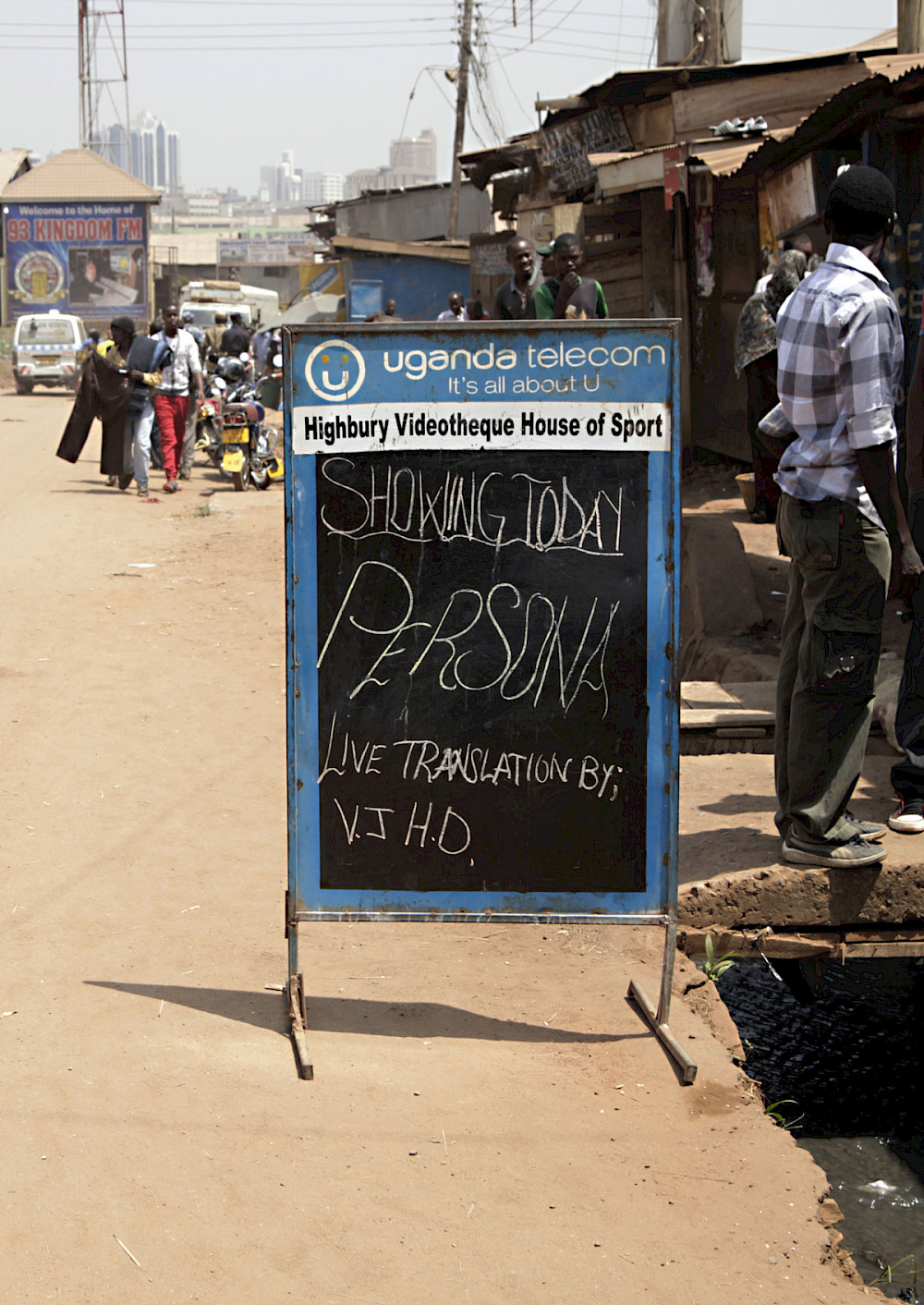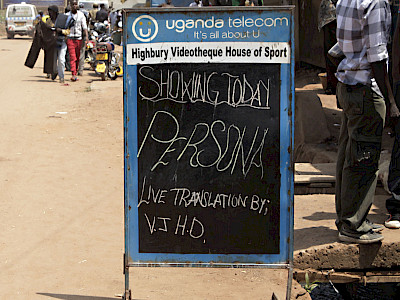08 — 11.05.2014
In Uganda, a new kind of folk storyteller has emerged in recent years: veejays. These are people who work in makeshift cinema halls in slums and remote villages. Their art consists of directly translating movies – usually Hollywood blockbusters – for the local audience. Swedish artist Markus Öhrn (remember Magic Bullet at the Kunstenfestivaldesarts 2013?) came up with the idea of showing the films of Ingmar Bergman in this particular cultural context. With his back to the big screen, Öhrn filmed the narrators issuing words and explanations of the complex introspections on European culture and lifestyle that are so emblematic of Bergman’s work. How does one watch Persona (1966) in the shantytowns of Kampala today? Not without irony, Markus Öhrn allows the European spectator to see how the African viewer looks at him. A confusing reversal that induces us to reflect on our own perspective.
Interview Markus Öhrn
Having reflected on the new colonialism in Africa in the video installation White Ants, Black Ants (2010), and in the theatre project, We Love Africa and Africa Loves Us (2012), Swedish artist Markus Öhrn stumbled on a very simple yet revealing format for reinterpreting white, bourgeois, existentialist art – as epitomised in Ingmar Bergman’s 1966 film Persona. With Bergman in Uganda, Öhrn lets the VJ, star of the Ugandan video hall and the teller of the true story behind every film, shine a light back on European culture. This unique installation puts the audience in the intermediate zone between the film Persona and the residents of Kampala’s largest slum, who view the film in a shed accompanied by commentary from the all-seeing VJ. As this video jockey, who comes from poverty himself, illuminates Ingmar Bergman’s masterpiece, he aptly compares life in a slum to life in a Swedish summerhouse, deconstructing white worlds in ways Öhrn could hardly have expected.
What inspired you to have Persona translated by a Ugandan VJ?
It started when I was doing a remake of a Swedish documentary from 1969 called White Ants, a post-colonial critique of how contemporary white Europeans have revived the same power structures as the 19th century colonists in Africa, but this time it’s the aid workers who live in the luxury houses with maids, and so on. I interviewed a guy from Uganda for the project, and he told me about the VJ tradition in the local video halls. At the time, I was also working with a Swedish author, Torbjörn Säfve, who had been in the Swedish film academy in the 1960s and shared an editing room with Ulla Ryghe, who had edited Persona for Ingmar Bergman. Torbjörn made collage films out of other people’s edits, so at night he took the Persona cuts from the rubbish bin and made a movie. After being shown at an experimental film festival in Stockholm in 1969, the film was confiscated by the Swedish Film Institute and has since disappeared. In 2009, I was making a documentary with Torbjörn in which we try to find his Persona collage film. When I was then told about the Ugandan VJs, I immediately thought that this could be a really interesting way to remake Ingmar Bergman’s film anew. What would happen if we went to Uganda and screened Persona, let a VJ translate it, and then translated it back into English?
You had never heard about movie VJs before?
No. I thought it was normal dubbing, like in Germany, for example. But then this Ugandan man explained that the VJ interprets the movie for the audience live, and tries to present the story in an understandable format so the film can be viewed with a Ugandan perspective. It’s a unique way of interpreting a film, because VJs also try to entertain their audience. They feel a responsibility to inspire them to stay and watch the movie. If the VJ feels it’s too boring or not relevant to the audience, he starts to interpret, to add things and make a few jokes. Like in Persona, the VJ compares the life that is being played out in front of them, to their own life in the slums.
Tell us about the so-called video halls where the VJs perform.
The video hall, a kind of cinema in the slums, is a very-very simple place. It’s basically a shed with a TV and some benches. Very few people living in the slums can afford to have their own TV or DVD player, so this is a way to watch films. In Kampala there are huge cinema complexes where you pay 20,000 Ugandan shillings to see a movie, around seven euros, which is impossible for poor people. So in slum areas, like the Kisenyi slum where I worked – the largest and roughest slum in the Kampala area, there are many video halls because it’s the only real entertainment experience they can get with little money. People spend a lot of time in these video halls. It’s the same for us; you escape from your daily problems, you go into this bubble. They also feel like they escape from their daily life.
Did the VJ struggle to translate a European art house film like Persona?
Most of what they show in these video halls is American action movies and romantic comedies, where the story runs by itself. But with Persona there is not so much happening. I mean, it has such a Scandinavian feel; it’s full of existential problems that don’t have the same value in a slum area in Uganda. So yes, I expected that this would be a challenge for the VJ, and it was. He was totally exhausted from trying so hard to keep the people in the cinema. Most of the VJs I have worked with have never gone to school in their life. They have only learned English through watching movies. Most people in the audience don’t speak much English and certainly won’t be able to read the subtitles. The VJ is not only relying on the text but is looking much more at what’s happening. There is a scene about riots in Vietnam during the war that he really goes into. The way he reflects on that situation, I think very few other people would do so that deeply when watching the movie.
In what other ways did the VJ try to make the film relevant to the local audience?
There’s a lot happening in Persona that is both uninteresting and irrelevant to the audience. These are people who die of different diseases – everything from malaria to aids – at a very early age. So when the VJ interprets the issue of suicide in the film, he says he can’t understand how white people commit suicide out of love. Of course, people commit suicide in the slums of Uganda as well, but it’s more likely related to economic problems or something other than love. These people ask themselves similar questions, but not in the way we do, because we have everything we need. The kind of mental illness presented in Persona, becoming mute or being burnt out, doesn’t exist in daily life in Uganda, because there it’s about getting food to your family, paying for the kids to go to school, trying to make a better life, especially if you’re living in a slum. The existential problems displayed in this movie are totally alien to them. A big part of the film is spent in a summerhouse, and the VJ is so confused about why the characters need to relax in a special house in the summer.
The VJ seems to struggle with the relationship between the women in the film.
Persona has been discussed in many ways. The relationship between the main female characters remains an open question, I guess. But because of the strong anti-gay culture in Uganda, they try not to even get into it. He mentions it once, saying that this is how homosexuality starts, through the way the women interact. It shows how their reality is filtered through this movie, because for us that’s not a threat. I talked a lot about homosexuality with the VJs. There’s paranoia around the subject [harsher anti-homosexuality laws have just been passed in Uganda], so I feel some responsibility as an artist, I mean they can get in really big trouble if they say something wrong and news gets out. They don’t even know that the movie Brokeback Mountain exists. No video hall would dare to screen it. There are churches everywhere in the slum. I remember when I screened The Seventh Seal by Ingmar Bergman, I was approached by two priests there who asked me about the meaning of the seventh seal. “Isn’t that the term for the devil?” they asked.
How did you feel about the outcome? Were you surprised?
Because I don’t understand the local Ugandan language at all, it was like walking in the dark. I really didn’t know what to expect. I was hearing people laughing; I could see others getting tired. It’s hard to say if it came out the way I wanted. But when you put it in the context of the installation, it becomes much more revealing. It’s very important to sit and look at this translation and to have Persona playing in the same room, because something happens; it feels like you’re transported somewhere and you learn something about yourself and about the people living in the slum. The VJ offers a summary of the ending that I feel is quite fitting. I don’t think many critics and people in Europe would come up with that kind of quick conclusion. It’s very interesting. I think this is because he’s free, he doesn’t know Ingmar Bergman, he doesn’t care about Ingmar Bergman, he doesn’t have a respect for him. And that’s quite interesting because he doesn’t read anything more into what he sees.
Concept, camera & editing by
Markus Öhrn
Featuring
Persona (1966) by Ingmar Bergman
VJ
HD
Translation
Kenneth Barongo
Subtitling
Stuart Braun
Presentation
Kunstenfestivaldesarts
Production
Markus Öhrn, Swedish Subterranean Movie Company
Supported by
Kunstenfestivaldesarts, Swedish Arts Grant Committee, Stadsschouwburg Amsterdam, Volksbühne am Rosa Luxemburgplatz (Berlin)


